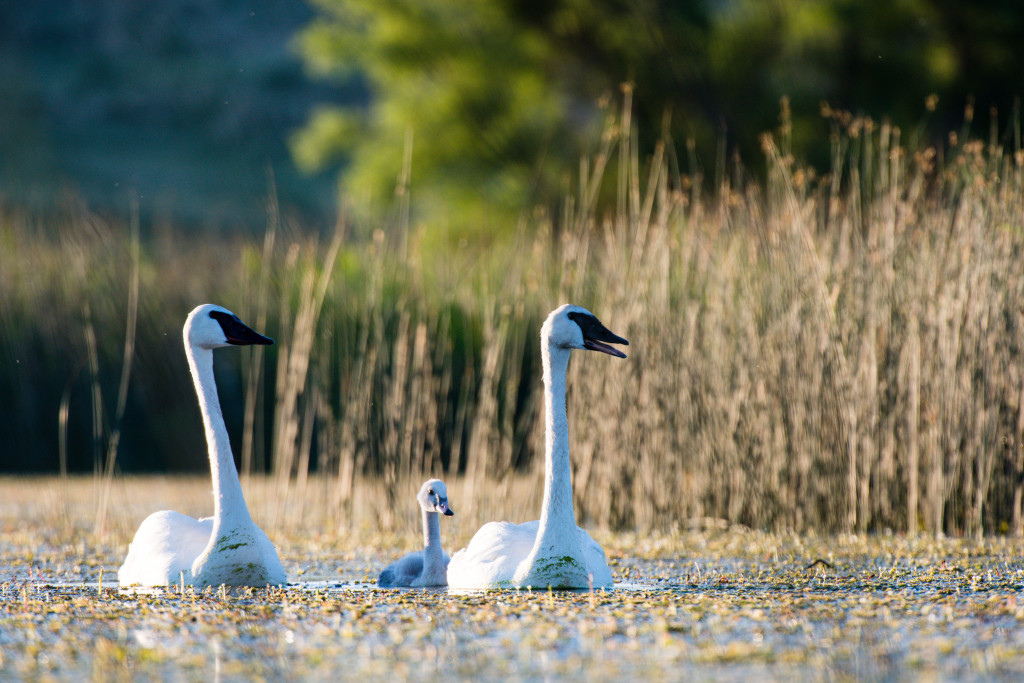
By Olivia DaRugna, Wildlife Diversity Biologist
Trumpeter swans are among the largest and heaviest of native waterfowl in North America, weighing about 25 pounds and standing close to 4 feet. Their large size makes getting airborne quite the achievement. Similar to an airplane, swans need a large, open space where they can gain enough speed, running to take flight using their long wings and shallow, rapid wingbeats to slowly gain altitude.
These elegant birds are entirely white except for their black bills and feet. Although they are large and white, trumpeter swans are surprisingly good at hiding themselves among the cattails and other lake vegetation on their breeding grounds. The swans occur all across the state during migration and can be found breeding in shallow sandhill lakes. A small number of swans also winter along rivers and lakes in central and eastern Nebraska.
Conservation
The trumpeter swan recovery is one of the great recent conservation success stories. By the early 20th century, trumpeter swans were nearly driven to extinction due to overharvesting for their meat, skins and feathers. Their large, snowy white feathers were coveted for fashionable hats and writing quills.
Since the passing of the Migratory Treaty Act in 1918, which gave protection to the trumpeter swans and many other birds, this species has been recovering. The North American population is estimated around 63,000 and continues to grow. While the swans have made an incredible recovery, they still face some threats, including lead poisoning, habitat loss and disturbance at their breeding grounds, where they are sensitive to human activity. In Nebraska, the trumpeter swan is a Tier II at-risk species in the Nebraska Natural Legacy Plan.
To help with the species’ recovery, young swans, called cygnets, were reintroduced to the Lacreek National Wildlife Refuge in South Dakota near the Nebraska border, where they thrived and eventually expanded into the Sandhills. Biologists for the Nebraska Game and Parks Commission fitted the swans with a neck collar that contained a unique code to identify individuals from a distance. The collars also had a GPS transmitter on them, which allowed biologists to remotely track the birds’ movements. To read more about this research, read this story written by Mark Vrtiska.
Observation Tips
This winter, bundle up and visit rivers and lakes where open water is reliably available for the best chances at seeing these magnificent birds. In eastern Nebraska, visit locations along the Missouri River such as Desoto NWR and nearby open waterbodies, such as Carter Lake in Omaha.
In central Nebraska, watch for the large, white birds along the Snake River in Cherry County, the Loup river system, the Platte River and large, unfrozen lakes such as Lake Ogallala. Visit the Birds of Nebraska- Online for more winter viewing locations.
Don’t forget to bring your binoculars! Chances are there will be bald eagles and many other species of waterfowl to watch for along with the swans. Plus, you may need the binoculars to help you distinguish between the similar-looking tundra swan, which occasionally can be found wintering with trumpeter swans. Tundra swans are smaller and their beaks are yellow in the area where the eye meets the bill. Additionally, the trumpeter swan’s black bill is more V-shaped where the bill and face meet compared to the U-shape of the tundra swan.
If you spot these elegant birds, remember you are seeing a true conservation success story right before your eyes. A hundred years ago, there were hardly any trumpeter swans left, and now, you don’t have to go far to enjoy this beautiful bird.
